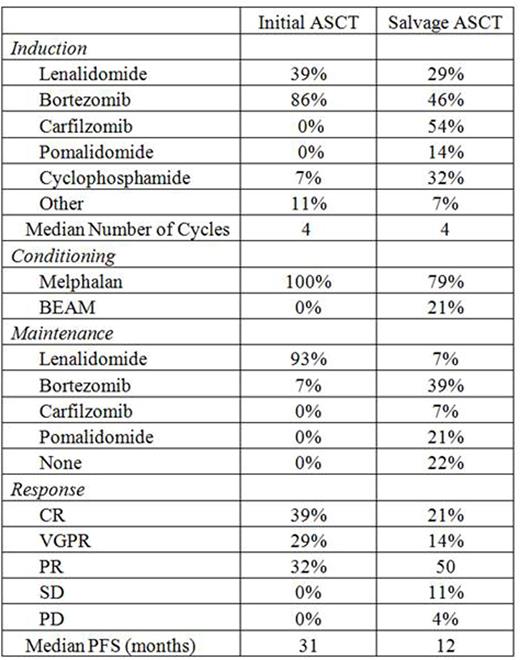Abstract
Background: For patients relapsing after initial autologous stem cell transplantation (ASCT), a second ASCT is a potential, although infrequently used, salvage option. Until recently, the benefits of second ASCT were unclear but recent prospective studies have shown second ASCT to improve PFS and OS compared to conventional salvage therapy. However, these studies have included few patients who received maintenance therapy following initial ASCT as maintenance therapy is a relatively recent innovation and is not standard of care in many EU countries where these studies where these studies were completed. Therefore, it is not currently clear if these patients benefit similarly from second ASCT.
Methods: We performed retrospective chart review of patients with multiple myeloma that received two ASCTs, one for initial treatment and one for salvage at time of relapse, between 2008 and 2016 at our institution. We identified 30 who received maintenance therapy following initial therapy; 2 patients were excluded as they experienced treatment related mortality prior to disease assessment post-ASCT, leaving 28 for the analysis.
Results: The median age of the study population was 59 years (range 48-69) at second ASCT. 64% (n = 18) were males, 36% (n = 10) females.
Prior to initial ASCT, the median number of induction cycles was 4 (range 2-11). 86% (n = 24) of patients received bortezomib during induction, 39% (n = 11) lenalidomide, 7% (n = 2) cyclophosphamide, and 11% (n = 3) received another agent. All patients received melphalan conditioning for initial ASCT. Maintenance therapy consisted mostly of lenalidomide (93%, n = 26); 7% (n = 2) had bortezomib maintenance due to lenalidomide intolerance. The overall response rate (ORR) was 100% (n = 28); the complete response rate was 39% (n =11). The median progression-free survival (PFS) post-ASCT was 31 months (range 9-57), the median interval between initial and salvage ASCT was 38 months (range 22-63).
At relapse, 93% (n =26) received reinduction chemotherapy while 7% (n = 2) went directly to salvage ASCT. The median number of reinduction cycles was 4 (range 2-28). 54% (n = 15) of patients received carfilzomib during reinduction, 46% (n = 13) bortezomib, 32% (n = 9) cyclophosphamide, 29% (n = 8) lenalidomide, 14% (n = 4) pomalidomide, and 7% (n = 2) received another agent.
Prior to second ASCT, 79% (n =22) received melphalan conditioning, while 21% (n = 6) received BEAM. 79% (n = 22) received maintenance therapy post transplantation; 39% (n = 11) received bortezomib, 21% (n = 6) pomalidomide, 11% (n = 3) lenalidomide, 7% (n =2) carfilzomib, 18% (n = 5) were observed off maintenance, and 4% (n = 1) had frank progression post-ASCT prior to starting maintenance. The overall response rate (partial response or better) was 86% (n = 24); the complete response rate was 21% (n = 6). The median estimated PFS was 12 months (95% CI 10-15). The median duration of follow-up was 16 months; the estimated 2 year overall survival was 49%.
Conclusion: In patients who relapse post-ASCT with maintenance therapy, the PFS following salvage ASCT is ~40% that of the initial ASCT. Strategies to improve outcomes using novel reinduction, conditioning, and post-transplant maintenance regimens are needed for these patients.
Wildes:Carevive Systems: Consultancy. Vij:Shire: Consultancy; Jazz: Consultancy; Karyopharma: Consultancy; Novartis: Consultancy; Janssen: Consultancy; Bristol-Myers Squibb: Consultancy; Celgene: Consultancy; Takeda: Consultancy, Research Funding; Amgen: Consultancy, Research Funding.
Author notes
Asterisk with author names denotes non-ASH members.


This feature is available to Subscribers Only
Sign In or Create an Account Close Modal